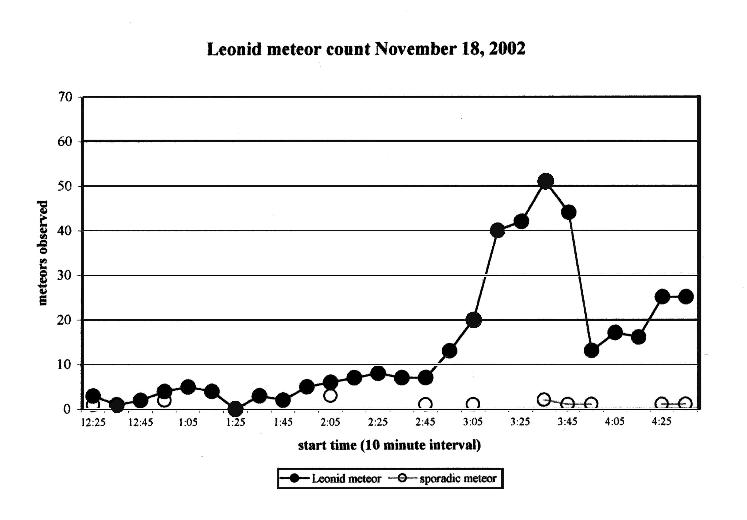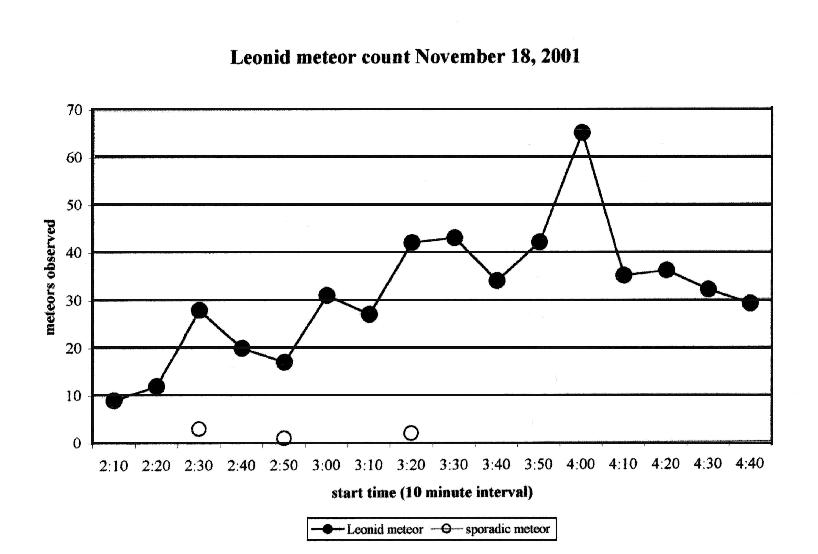
Richard E. & Dolores H. Hill JIM LOUDON OBSERVATORY 10130 E. King Manor Tucson, AZ 85730 Longitude:110.77554 deg. W or 110 deg. 46' 31.9" Latitude: 32.18006 deg. N or 32 deg. 10' 48.2" Height above sealevel: 2875 ft.
===================================================Equipment:
- C5 with a 24mm teleview eyepiece attached to a PC-164 camera with a 4mm f/1.2 lens. The resultant f/ratio of the afocal projection is f/1.7 with a field of 0.9o. - Another PC-164 video camera with a 4mm f/1.2 lens imaging an area of sky about 65o by 75o - Visual observation and counting.
===================================================
Two peaks were predicted for this shower. The first (from a 1767 trail of Comet Tempel-Tuttle) was for just after 4 hours UT and best placed for longitudes from the mid-Atlantic eastwards to the sunrise line. Nevertheless we made an attempt to record what we could for this early maximum using the PC-164 video camera and a 4mm f/1.2 lens, hoping for an atmosphere skimming meteor. No significant events were recorded that could definately be attributed to the Leonid shower.
Activity picked up by midnight and several bright meteors were seen in Gemini shortly after 12:00 as cameras were being set up. These were the brightest of the night at about zero magnitude.So recording was begun earlier on this second maximum (from the 1866 trail of debris) than originally planned.Meteors were recorded the first minute. As the plot below shows, meteor counting was begun at 12:25 MST (0725 UT). Most of the counting was done directly off a monitor for the PC-164 wide field (~65o x 75o) camera. This had the advantage of showing more meteors than the naked eye could see in the bright moonlight and confining the observer's vision to a specific field that could then later be related to the whole sky in determining a zenithal rate that could be redetermined or verified on the long term storage medium. The mean peak of the shower appears to have occured around 03:30 MST on the 19th of November, or at 1030 UT. Within the larger peak was a small maximum around 03:40 MST (1040 UT).
The C5 was used in afocal projection to give a field of 0.9o working at f/1.7. This was used to videotape the radiant through the predicted peak of the second predicted maximum. No significant, unambiguous events were recorded to 10th magnitude.
Visually, after the main peak the general number of meteors dropped to a little over an average of one per minute but then began to increase from that. If the large maximum is ignored one sees a fairly linear increasing trend from 01:25 MST to the end of the observing period that hints at the possibility of another later broad peak.

Below is a similar plot for the 2001 Leonid shower. It shows that the build-up was more gradual with a small sharp maximum at 04:00 MST. This was caused from the 1767 trail debris.
